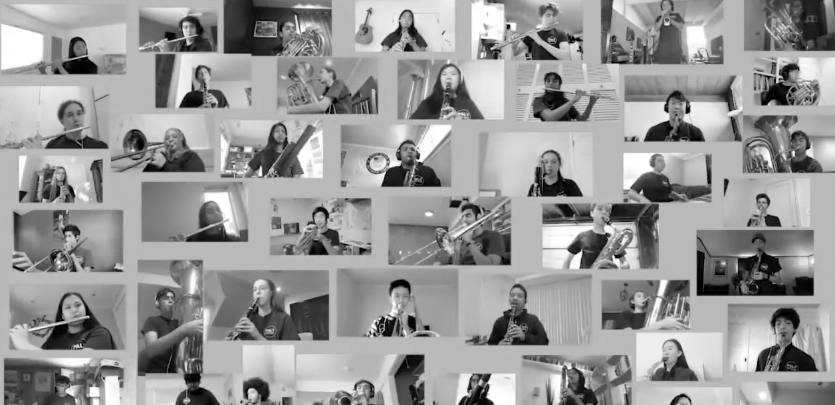Makeup, clothes and props ready, junior Arnav Singhal looks into the camera, preparing to put on one of the semester’s biggest plays for a faceless audience. This year, he is performing at home, with a greenscreen hanging behind him and his fellow actors mere two-dimensional images on a shared Zoom call.
Each situated in their own rectangles, actors and musicians in Paly’s performing arts programs have adapted to the conditions made necessary by the COVID-19 pandemic, and their virtual performances have each taken their own spin on the classic, in-person kind.
As an actor in the murder mystery play “Clue,” one of three plays that Paly Theater put on this fall, Singhal said that being able to experiment with different filters and virtual backgrounds has been a unique experience.
“I think it’s cool that we have the capability of technology to at least sort of make up for (performing virtually), and it’s interesting to see how we can use it creatively, especially technology that we normally would not have used for theater,” Singhal said. “Like dungeons and dangers are not theater, but we’ve managed to make it work and it looks pretty cool.”
Singhal also said that in order to put on a successful play, he and the rest of the actors needed to adapt to performing virtually — and, in a way, almost relearning how to act.
“A big part of theater is it being live,” Singhal said. “So I’m on a stage. I can see the audience. I can hear their reaction. I can see their reaction. And most of that has gone away over Zoom or other forms of virtual theater because you can’t really see the audience or see their reactions. A source of energy for me is a way to feed off of that and continue my performance so I sort of have to motivate myself and be like, ‘I’m sure they like it’ and that kind of a thing.”
Band teacher Greg Miller said the technological limitations of teaching virtually have been one of the biggest learning challenges that he and his students have faced so far.
“We can’t hear our students like we would normally if we were all teaching in-person,” Miller said. “The normal model (is that) I give a direction, students play something, I listen to that, I listen to see what they can do better, give that feedback, have them do it again … And that’s kind of gone. So we had to find ways to recreate that.”
Miller said students in his classes have been adapting to different forms of rehearsing and practicing, including playing along with a clicktrack, using apps like Smartmusic and Soundtrap to record themselves and breaking out into instrument groups to rehearse with only one student unmuted at a time.
Junior clarinetist Natalie Nguyen said that this method of rehearsal has been going well for her so far, but there are still downsides to rehearsing virtually.
“I definitely miss being able to play in person, but we have still been able to practice together as a group,” Nguyen said.
She also said she has enjoyed working with the other students in her section, and that hearing everyone play together in the virtual concerts that Paly’s band directors have put together has been great.
Miller said he also became much better at putting virtual performance videos together, especially compared to when he was assembling videos in the spring.
“Now that I’ve kind of got the skill set — at least the basic skill set of video production — it’s pretty fun for me personally to put together the videos and then to share them with the students in class and watch them see themselves perform together, even though they all recorded at home,” Miller said. “They’re an opportunity just to have a nice distraction from the world and enjoy music that the students have worked really hard to put together.”
And although Singhal believes that many of the technical elements of Zoom would not be used when plays are performed in-person again, he said he has learned new skills and tried new ways of expressing his character through his performance.
“I think we’ve discovered in this production for virtual Zoom that a lot of stuff is doable if you just try to find ways,” Singhal said. “I thought like, ‘Oh, how’s this going to work? How’s it going to look like someone is handing me a gun?’ But then we troubleshooted it. We tried to make it work using virtual backgrounds and using Zoom on and off to place each person next to each other. And it works pretty well, so I think that we now know that a lot more is possible than at least I would have thought.”



